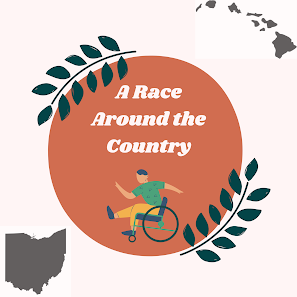A Race Around the Country
During my Biomechanics class, we were given the chance to read parts of a book called "50 Abilities, Unlimited Possibilities: Racing to the Final Finish Line From Salt Lake City to the Mountains of Montana" by Paul Erway. Paul Erway and two other fellow racers were wheelchair racers that set a goal to finish 50 marathons in all 50 states in 50 weeks. This book is the second and final part of the series that gives us a more in-depth behind-the-scenes of their final 36 races since the first book was about the first 14. I read about their marathons in the states of Ohio and Hawaii and learned a lot about what the three of them went through to complete this goal and what it took to cross that finish line. As I read the parts of the book, it made me realize the struggles they faced during this journey and even during the marathon as wheelchair users.
Dayton, Ohio was the 32nd marathon that the group of three had decided to participate in. During this chapter, Erway goes into detail about how reality was setting in and it was harder to participate in races as unexpected schedule changes would occur as well as personal conflicts. As I was reading this, I never really realized how hard doing a marathon in a wheelchair would truly be until Erway went into full detail about his experience. This marathon was at an Air Force Base and the path would go in waves from being flat to being steep, to going downhill and flat again. He mentions that it was raining that day and even though it was helping them keep cool, he said that the rain would be hard on the wheelchair as it could cause them to lose grip on their push rims. Our class happened to have a wheelchair lab recently and I got to have the experience of pushing myself in the wheelchair and pushing someone else in the wheelchair. Honestly, it was a struggle at first because don't realize how much arm strength goes into pushing yourself and someone else. When I read that sentence about the rain, I could just imagine how much harder it would be to push in the rain. Another point Erway mentioned and went into detail about is what it is like when competing in a marathon while you are sick. He mainly highlighted urinary tract infections (UTIs). For someone who had a spinal cord injury, they use intermittent catheterization which makes them more susceptible to getting UTIs. This can lead to severe pain, high fever, and painful and frequent urination. All while trying to meet the set goal, Erway and his group had to make sure their immune systems were strong enough to get them through the marathon, but with a rigorous race schedule, it was hard to even get proper sleep. This would put their immune systems at risk and give them a higher chance of getting an infection. Erway did mention that getting sick did happen throughout the journey, sometimes making it hard to get in contact with a doctor since they were always in a different state, but they pushed through in a healthy manner, keeping an eye on the prize of accomplishing the goal.
Honolulu, Hawaii was marathon number 47. This place intrigued me because it isn't just every day you hear someone going to Hawaii for a marathon. Erway brings a little light on how he thought he was going to be greeted by a Hawaii native in a grass skirt and would place a lei around his neck. However, in reality, he saw an elderly woman at baggage claim in the airport selling various types of leis. The Honolulu marathon is one of the largest in the world and about half of the 30,000 people that entered the marathon were from Japan. When the race began, Erway talks about how he and 10 other wheelchair racers and 23 hand cyclists were escorted to the starting line by a few motorcycle cops and other bicycle riders. Even though it was nice to have that attention and cheering from the crowd, he mentioned that he had to take extra time out to be in racing chairs and be prepared 45 minutes before the race even started. This is a bit unfair because the longer he sits, he could start to get pressure ulcers from being in a position for too long and not being able to distribute the weight. Another thing Erway mentioned that stuck out to me was how he paid attention to the roads. He said he noticed the race path had been repaved because he felt as if he was going faster than normal and not running into cracks and potholes. He also said at another point that volunteers would come out to stand and separate the runners from the other wheelchair racers. Usually, they would just place cones, but he appreciated the volunteers because sometimes the runners would ignore the cones and run wherever they want, which would lead to unsafety and probably chaos. Something else that got my attention was when Erway slightly mentioned his back tire making a loud noise, which is a thought I would have never realized would be a huge issue. Imagine if the tire fully popped and came off, that would cause his wheelchair to probably flip and injure him.
In the two chapters I was able to read about his marathon experience in Dayton, OH and Honolulu, HI, I learned a lot about the perspective on how wheelchair users participate in marathons. It also just gave more enlightenment on the different considerations you have to truly think about. I was not really aware of how sitting for long periods of time could lead to serious infections and irritability. Even the social aspect of what it is like to be a wheelchair user captivated me because wheelchair users notice things that people that do not use wheelchairs don't. This made me want to continue to advocate for what our profession does as we like to be inclusive and understand how other people feel. The two chapters I read were enlightening, yet powerful, and also had a touch of humor. This was a good read to truly put yourselves in the shoes of Paul Erway and his friends and see how they were determined to accomplish their goal of finishing 50 marathons in all 50 states in 50 weeks.
Erway, P. (2019). 50 abilities, unlimited possibilities: Racing to the final finish line from Salt Lake City to the mountains of Montana. Silver Tree Communications.





Pinal, in my reading Paul also talked about how hard the terrain was. It really opened my eyes to how inaccessible some places are. I liked how you discussed how Paul said how it felt to be separated from the other runners. Your post has taught me about the different health issues wheelchair users encounter when racing such as UTIs and pressure ulcers as I did not realize those would be relevant during a marathon.
ReplyDeletePinal, I really enjoyed reading and learning from your blog. I agree that navigating a wheelchair on steep surfaces is challenging and even more with the presence of rain. I also liked that you considered the many health issues experienced by many wheelchair racers such as the creation of pressure ulcers. I wonder if the rain could also add to the risk of ulcers due to the increase friction?
ReplyDelete